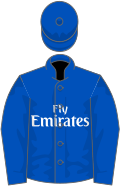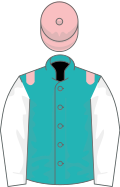Top Qs
Timeline
Chat
Perspective
Prix du Cadran
Flat horse race in France From Wikipedia, the free encyclopedia
Remove ads
The Prix du Cadran is a Group 1 flat horse race in France open to thoroughbreds aged four years or older. It is run at Longchamp over a distance of 4,000 metres (about 21⁄2 miles), and it is scheduled to take place each year in early October.
| 2024 | ||
 |
 |
 |
| Kyprios | Trueshan | Coltrane |
It is France's most prestigious race for "stayers" – horses which specialise in racing over long distances. It is the French equivalent of the Gold Cup, the leading stayers' race in Great Britain.
Remove ads
History
Summarize
Perspective
The event is named after a clock face (cadran) at the École Militaire, a building located alongside its original venue, the Champ de Mars. It was first run in 1837, and was initially contested over one and a quarter laps of the track, about 2,500 metres.
The race was extended to 4,000 metres in 1843, and increased to 4,200 metres in 1846. It was held at Versailles in 1848, due to that year's French Revolution. It was not run in 1850, and its distance changed several times in the following decade. It was restricted to four-year-olds in 1854. It was transferred to Longchamp in 1857, and reverted to 4,200 metres in 1858. It was cancelled in 1871, because of the Franco-Prussian War.
The Prix du Cadran was re-opened to horses aged five or older and cut to 4,000 metres in 1913. It was abandoned throughout World War I, with no running from 1915 to 1918. It was cancelled once during World War II, in 1940. It was staged at Le Tremblay over 4,100 metres from 1943 to 1945. It was abandoned because of student protests in 1968.
The present system of race grading was introduced in 1971, and the Prix du Cadran was classed at the highest level, Group 1. For a period it took place in late May. It was opened to geldings in 1986.
The race was moved to the Saturday of Prix de l'Arc de Triomphe weekend in 1991. It was later switched to the same day as the "Arc", usually the first Sunday in October.
Remove ads
Records
Most successful horse (4 wins):
- Marsyas – 1944, 1945, 1946, 1947
Leading jockey (5 wins):
- Yves Saint-Martin – Waldmeister (1965), Danseur (1967), Recupere (1974), Buckskin (1977, 1978)
Leading trainer (15 wins):
- Tom Jennings – La Cloture (1851), Hervine (1852), Papillon (1854), Monarque (1856), Compiegne (1862), Alerte (1863), Beatrix (1865), La Fortune (1866), Auguste (1867), Longchamps (1868), Le Sarrazin (1869), Boulogne (1870), Saint Christophe (1878), Rayon d'Or (1880), Milan (1881)
- (note: the trainers of some of the early winners are unknown)
Leading owner (11 wins):
- Frédéric de Lagrange – Compiegne (1862), Alerte (1863), Beatrix (1865), La Fortune (1866), Auguste (1867), Longchamps (1868), Le Sarrazin (1869), Boulogne (1870), Saint Christophe (1878), Rayon d'Or (1880), Milan (1881)
Remove ads
Winners since 1969
- The 2016 and 2017 races took place at Chantilly while Longchamp was closed for redevelopment
Remove ads
Earlier winners
Summarize
Perspective
- 1837: Miss Annette
- 1838: Franck
- 1839: Nautilus
- 1840: Nautilus
- 1841: Deception
- 1842: Nautilus
- 1843: Annetta
- 1844: Nativa
- 1845: Edwin
- 1846: Tomate
- 1847: Liverpool
- 1848: Morok
- 1849: Nanetta
- 1850: no race
- 1851: La Cloture
- 1852: Hervine
- 1853: Trust
- 1854: Papillon
- 1855: Remuneration
- 1856: Monarque
- 1857: Nat
- 1858: Potocki
- 1859: Martel en Tete
- 1860: Geologie
- 1861: Pretendant
- 1862: Compiegne
- 1863: Alerte
- 1864: Guillaume le Taciturne
- 1865: Beatrix
- 1866: La Fortune
- 1867: Auguste
- 1868: Longchamps
- 1869: Le Sarrazin
- 1870: Boulogne
- 1871: no race
- 1872: Veranda
- 1873: Revigny
- 1874: Boiard
- 1875: Saltarelle
- 1876: Saint Cyr
- 1877: Enguerrande
- 1878: Saint Christophe
- 1879: Clocher
- 1880: Rayon d'Or
- 1881: Milan
- 1882: Bariolet
- 1883: Seigneur
- 1884: Regain
- 1885: Archiduc
- 1886: Lapin
- 1887: Sauterelle
- 1888: Krakatoa
- 1889: Siberie
- 1890: Clover
- 1891: Mirabeau
- 1892: Berenger
- 1893: Chene Royal
- 1894: Fousi Yama
- 1895: Excuse
- 1896: Omnium II
- 1897: Olmutz
- 1898: Chambertin
- 1899: Le Roi Soleil
- 1900: Perth
- 1901: Ivoire
- 1902: La Camargo
- 1903: Astronome
- 1904: Camisole
- 1905: Gouvernant
- 1906: Strozzi
- 1907: Ris Orangis
- 1908: Kalisz
- 1909: Sauge Pourpree
- 1910: Aveu
- 1911: La Francaise
- 1912: Combourg
- 1913: Predicateur
- 1914: Nimbus
- 1915–18: no race
- 1919: Bridaine
- 1920: Samourai
- 1921: Odol
- 1922: Ksar
- 1923: Le Prodige
- 1924: Filibert de Savoie
- 1925: Cadum
- 1926: Priori
- 1927: Asteroide
- 1928: Nino
- 1929: Cacao
- 1930: Hotweed
- 1931: Chateau Bouscaut
- 1932: Brulette
- 1933: Gris Perle
- 1934: Thor
- 1935: Brantôme
- 1936: Chaudiere
- 1937: Fantastic
- 1938: Dadji
- 1939: Foxlight
- 1940: no race
- 1941: Maurepas
- 1942: Nepenthe
- 1943: Hern the Hunter
- 1944: Marsyas
- 1945: Marsyas
- 1946: Marsyas
- 1947: Marsyas
- 1948: Arbar
- 1949: Turmoil
- 1950: Ciel Etoile
- 1951: Ysard
- 1952: Mat de Cocagne
- 1953: Feu du Diable *
- 1954: Silex
- 1955: Elpenor
- 1956: Bewitched
- 1957: Cambremer
- 1958: Scot
- 1959: Tello
- 1960: Le Loup Garou
- 1961: Puissant Chef
- 1962: Taine
- 1963: Taine
- 1964: Azincourt
- 1965: Waldmeister
- 1966: Fantomas
- 1967: Danseur
- 1968: no race
* Vamos finished first in 1953, but he was disqualified.
Remove ads
See also
References
Wikiwand - on
Seamless Wikipedia browsing. On steroids.
Remove ads
































































